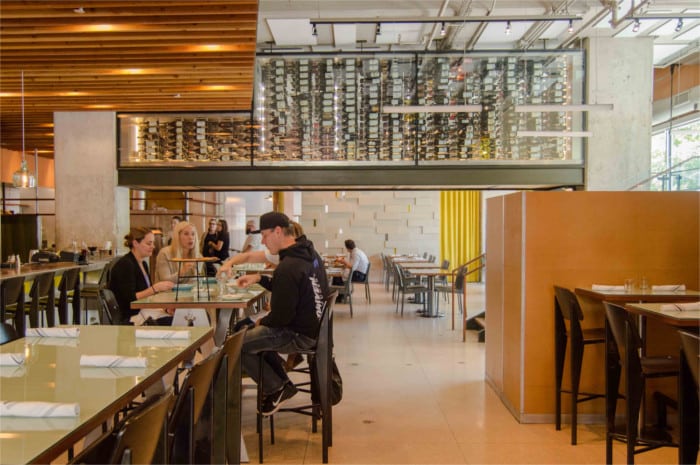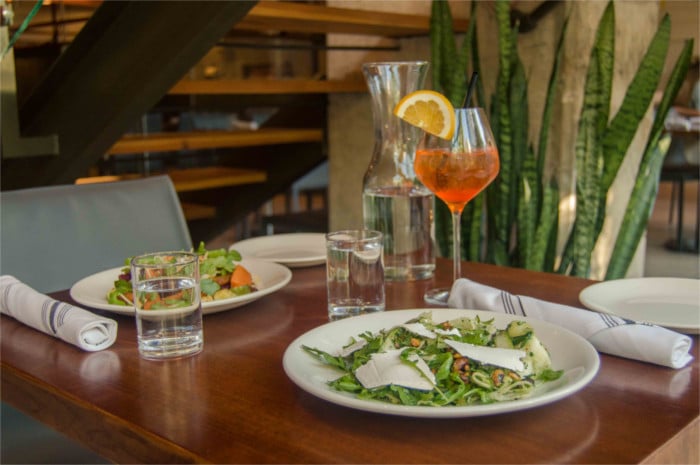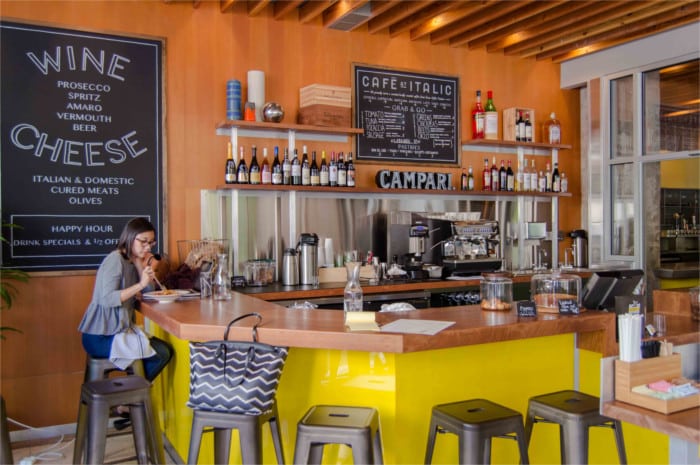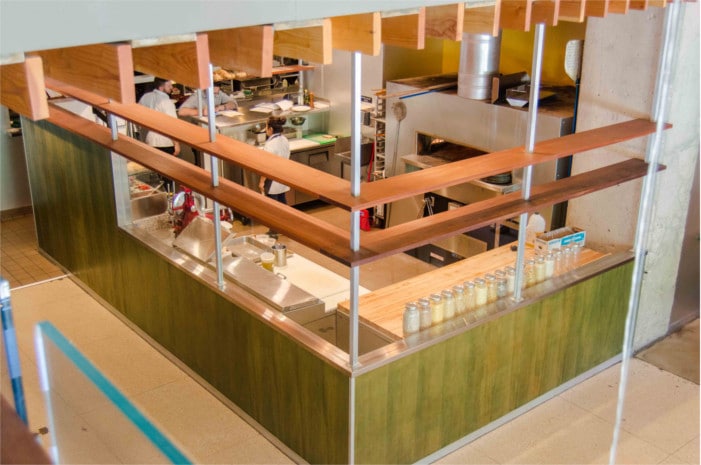
Inside Italic on West Sixth Street
Do you know an easy way to find out how good the food is in a restaurant? Order a dish made of vegetables. When you order a pasta with meat sauce that has been slow-cooked for hours, or a pizza with cheese bubbling on top, you know it’s going to be good. But if a chef can turn zucchini into a dish even a carnivore would adore and make roasted carrots burst with flavor, rest assured you are in the right place.
I started my meal at Italic–a rustic Italian restaurant in downtown Austin–with zucchini served with ricotta salata and pistachios. It was so good I considered the crazy idea of sticking to primi for the rest of my meal. I’m sure I would’ve left perfectly happy and satisfied (although misunderstood by the staff members).

Primi with an Aperol spritz
But then I realized: if zucchini tastes like heaven here, what’s the pizza like? And so zucchini was followed by pasta Bolognese, prosciutto pizza and apple crostata. If you think that’s a lot of food for one meal, you should understand the culture of eating in Italy. A slow unrushed dinner featuring five or six courses is normal. And that’s the kind of dining Italic’s chef Andrew Curren inspires us to try. In his own words,
It’s not about me or my food, it’s about Italy, the culture that gave us this style of dining.
While you can come here for dinner and order a pizza or main dish, Italic gives you the option to experience true Italian tradition by choosing a family-style meal. With it, you’ll have dinner like Italians do: starting with antipasti like olives or prosciutto, trying a salad, then moving on to two different types of pasta, followed by a main dish like roasted chicken with polenta or vegetables, and finishing with dessert. It doesn’t matter whether you’ve planned a romantic dinner for two or a gathering for twenty people. Having a family-style dinner always means taking time to enjoy food, wine and conversation.
On the other hand, if you don’t have time for a proper meal, you can drop by for a shot of espresso and a quick sandwich at the bar and keep going. Coffee bars are common in Italian cities, so situating one at the front of the restaurant is another cultural aspect embraced by Italic.

Italic’s coffee bar
No matter whether you choose to dine family-style or order a few plates off the menu, you’ll be pleasantly surprised by the ever-changing options. As Chef Curren explains,
I call it Italian sensibility! You look outside and say: What are we eating today?
If it’s cool outside, the inspiration for the menu is drawn from the northern parts of Italy. In the hot months of summer–from southern Italy and Sardinia. Italic’s menu is highly seasonal and depends on the climate of Austin. For example, with fall coming to the city, the dessert menu has an addition of apple crostata (sweet apples wrapped in buttery and crumbly dough) and pumpkin cannoli.

Apple crostata, a seasonal addition to Italic’s menu
There’s also a new section of the menu dedicated to the dishes of Piedmont–a region in Italy where truffles originate. Truffles are in season right now, so white truffle tagliatelle has made an appearance on the menu, and you can pair it with Piemontese wine Nebbiolo from G.D. Vajra.
Apart from seasonal changes, there are three to four daily alterations in the menu, including new types of pasta, ravioli or mezzaluna.
Cooking farm to table not to be in trend with what’s happening in the world, but to be honest to Italian traditions.
Seasonality is only one part of Italian cooking culture that Italic has adopted. Fresh, high-quality ingredients are another.
Fresh ravioli, gnocchi, linguine, pappardelle and fettuccine are prepared in house every day. Best brands of dry pasta are sourced from Italy. Prosciutto comes from the San Daniele del Friuli area of Italy and is aged for 18 months. Parmigiano-Reggiano is delivered in 100-pound wheels every 10 days. Tomatoes are sourced solely from San Marzano, considered by many chefs to produce the best in the world. There are always at least five varieties of olive oil in the kitchen for different purposes from both Italy and California.

Looking down into Italic’s kitchen
Lamb is delivered whole and broken into pieces in the kitchen. Different parts of lamb are incorporated into dishes throughout the menu: lamb chops, ragu, braised lamb shoulder tossed with pasta and lamb sausage.
The idea is to pay respect to ingredients by sourcing the best and minimally processing them. Every dish contains no more than 5-6 ingredients, making presentation clean and straight-forward.
And then there’s the 100 percent Italian wine list and classic Italian cocktails like Negroni and Aperol spritz. The latter is my personal reason to fall in love with this place, since this simple heavenly drink is not easy to find in American restaurants.
People ask whether our pizza is Northern Italian or Neapolitan. It’s a pizza we created to take the best qualities of each region.
Italic’s pizza is thin, crispy on the bottom with slightly charred edges. Chef Curren admits he has been making pizza dough for a long time and the result is a unique twist on the traditional recipe. Like in Italy, “00” flour is used, which makes the dough tender and light. But you can find an unexpected ingredient in Curren’s dough, beer, that gives it a malty characteristic.

Prosciutto pizza and pasta Bolognese
The American-made stone hearth oven cooks pizza quickly and is the reason behind the crispiness on the bottom. While the temperature in the hearth is around 550 degrees, the temperature in the dome goes up to 1,000 degrees, which is why the pizza comes out slightly charred on the edges.
Chef Curren’s favorite is prosciutto pizza served at lunch, featuring arugula and two eggs. Although egg on pizza is a surprise for me, Curren says it’s not an unusual combination and the first time he tried it was in Italy. Rocket and speck pizza with egg on top, which he tasted during his studies in Tuscany, served as inspiration for the prosciutto pizza on Italic’s menu.
In today’s culinary world, there are two types of chefs: cerebral and emotional.
When I first met Andrew Curren, he mentioned that his food is emotional. “That’s an interesting way to put it,” I thought to myself, and jumped at the opportunity to ask him more about this concept. In his opinion, there are two types of cooks in today’s kitchens: cerebral and emotional.
Cerebral chefs prepare food that is beautiful. It might taste amazing or it might not, but the main distinction is that it’s prepared for the chef himself rather than for the guest. In a way, it’s selfish food.
Emotional chefs, the category I think Curren falls into perfectly, make food for people and with their emotions in mind. It’s the kind of food that inspires happiness, nostalgia, and great memories of people, places, or holidays. The food doesn’t leave you thinking: was it good? Did I like it? But it makes you fulfilled, satisfied and craving more.
123 W. Sixth St. – Website
@theAustinot wants to know:
What is your favorite dish at Italic?
Disclosure: Italic graciously comped my meal during my recent visit for the purposes of this review. All opinions are my own.
Yulia Dyukova is a Russian food and travel blogger at thefoodiemiles.com, currently based in Austin, TX. She is the kind of person who starts to research a new country by googling “what to eat in…” instead of “what to visit in…” Having come across a particularly mouth-watering dish, she feels obliged to share it with the world.
- Day Trip in Austin: 10 Places To Visit Like a Tourist - December 1, 2021
- Austin’s Top Chefs: Reyna Vasquez of Veracruz All Natural - November 28, 2017
- Texas Monthly BBQ Fest Brings the Best Meat With (Almost) No Lines - November 8, 2017

Nice post! Nothing beats my nana’s meatballs. 🙂 Best Italian food is when you have a glass of wine after eating. When I go to an Italian restaurant, I look for their special offers and food authenticity! Cheers!
Italian cuisine is the best! In general, there are so many wonderful things in Italy: the sea, ancient architecture, pizza and pasta, and much more. I can’t wait for my vacation to go there. I have found so many interesting places here that I am not sure if I have enough time for everything.